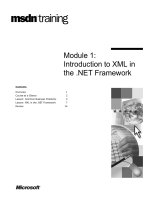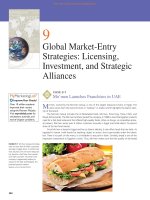Ebook Global marketing (4/E): Part 1 - Kate Gillespie
Bạn đang xem bản rút gọn của tài liệu. Xem và tải ngay bản đầy đủ của tài liệu tại đây (2.96 MB, 307 trang )
2
3
Global Marketing
Fourth Edition
This textbook introduces students to the important concepts of global marketing today, and their
managerial implications. Designed to be shorter than many other textbooks, Global Marketing focuses on
getting to the point faster.
Increasingly, marketing activities must be integrated at a global level. Yet, the enduring influence of culture
requires marketers to adapt local strategies in light of cultural differences. Global Marketing takes a similar
strategic approach, recognizing the need to address both the forces of globalization and those of localization.
Other key features include:
■ Coverage of often overlooked topics, such as the competitive rise of China’s state-owned enterprises;
the importance of diasporas as target markets; and the emerging threat to legitimate marketers from
transnational criminal organizations.
■ A chapter dedicated to understanding global and local competitors, setting the stage for ongoing
discussion of both buyers and competitors in an increasingly competitive global marketplace.
■ Extensive real-life examples and cases from developed and emerging markets, including insights into
the often-overlooked markets of Africa, Latin America, and the Middle East.
Written in a student-friendly style, previous editions have received praise from both students and instructors.
This edition continues to build on this strong foundation, making this the book of choice for students of
global marketing classes.
Kate G illespie is Associate Professor of International Business and Marketing at the University of Texas at
Austin, USA. She has served as chair of the Global Marketing Special Interest Group of the American
Marketing Association, and her research has appeared in top academic journals in the fields of international
business, marketing, and area studies.
H . D avid H ennessey is Professor (Emeritus) of Marketing and International Business at Babson College,
USA. He has taught courses on global marketing, marketing strategy, and sales strategy, and has participated in
executive education programs around the world.
4
Global Marketing
Fourth Edition
Kate G illespie and H . D avid H ennessey
5
First published 2016
by Routledge
711 Third Avenue, New York, NY 10017
and by Routledge
2 Park Square, Milton Park, Abingdon, Oxon OX14 4RN
Routledge is an imprint of the Taylor & Francis Group, an Informa business
© 2016 Taylor & Francis
The right of Kate Gillespie & H. David Hennessey to be identified as authors of this work has been asserted by him/her
in accordance with sections 77 and 78 of the Copyright, Designs and Patents Act 1988.
All rights reserved. No part of this book may be reprinted or reproduced or utilised in any form or by any electronic,
mechanical, or other means, now known or hereafter invented, including photocopying and recording, or in any
information storage or retrieval system, without permission in writing from the publishers.
Trademark notice: Product or corporate names may be trademarks or registered trademarks, and are used only for
identification and explanation without intent to infringe.
Library of Congress Cataloguing-in-Publication Data
Gillespie, Kate.
Global marketing / by Kate Gillespie and David Hennessey. —
4th edition.
pages cm
Includes bibliographical references and index.
1. Export marketing. 2. Export marketing—
Management. I. Hennessey, Hubert D. II. Title.
HF1416.G54 2015
658.8’4—dc23
2014041447
ISBN: 978-0-7656-4295-0 (hbk)
ISBN: 978-1-315-71688-6 (ebk)
Typeset in Sabon
by Apex CoVantage, LLC
6
Brief Contents
Preface
Acknowledgments
1 Intro ductio n to G lo bal M ark eting
Part 1 U nderstanding the G lo bal M ark eting E nviro nment
2 T he G lo bal E co no my
3 C ultural and So cial F o rces
4 Po litical and R egulato ry C limate
Part 2 Analyzing G lo bal O ppo rtunities
5 G lo bal M ark ets
6 G lo bal C o mpetito rs
7 G lo bal M ark eting R esearch
Part 3 D evelo ping G lo bal Participatio n Strategies
8 G lo bal M ark et Participatio n
9 G lo bal M ark et E ntry Strategies
Part 4 D esigning G lo bal M ark eting Pro grams
10 G lo bal Pro duct Strategies
11 G lo bal Strategies fo r Services, B rands and So cial M ark eting
12 Pricing fo r Internatio nal and G lo bal M ark ets
13 M anaging G lo bal D istributio n C hannels
14 G lo bal Pro mo tio n Strategies
15 M anaging G lo bal Advertising
Part 5 M anaging the G lo bal M ark eting E ffo rt
16 O rganizing fo r G lo bal M ark eting
Country Market Report
Glossary
Index
7
8
Detailed Contents
Preface
Acknowledgments
1 Intro ductio n to G lo bal M ark eting
The Importance of Global Markets
Why Companies Seek Global Markets
The Development of Global Marketing
Domestic Marketing
Export Marketing
International Marketing
Pan-Regional Marketing
Global Marketing
Why Study Global Marketing?
A Need for Global Mindsets
Organization of This Book
Part 1 U nderstanding the G lo bal M ark eting E nviro nment
2 T he G lo bal E co no my
International Trade: An Overview
International Dependence of Nations
The Growth in World Trade
The Basic Theories of World Trade: Absolute, Comparative and Competitive Advantage
Absolute Advantage
Comparative Advantage
Competitive Advantage
Global Outsourcing
Balance of Payments
Exchange Rates
The Foreign Exchange Market
9
Causes of Exchange Rate Movements
Managed Currencies
Implications for Global Marketers
International Agencies for Promoting Economic and Monetary Stability
International Monetary Fund (IMF)
World Bank
Group of Seven
Protectionism and Trade Restrictions
Tariffs
Quotas
Orderly Marketing Arrangements and Voluntary Export Restrictions
Nontariff Trade Barriers
Restrictions on Foreign Exchange
General Agreement on Tariffs and Trade (GATT)
World Trade Organization (WTO)
Economic Integration as a Means of Promoting Trade
Free-Trade Areas
Customs Unions
Common Markets
Monetary Unions
The Globalization Controversy
3 C ultural and So cial F o rces
A Definition of Culture
Cultural Influences on Marketing
Isolating Cultural Influences
Religion
Marketing and Western Religions
Marketing and Islam
Marketing and Eastern Religions
The Family
Extended Families
Beyond the Family
Education
10
Attitudes Toward Time
Monochronic versus Polychronic Cultures and Temporal Orientation
Work and Leisure Time
Material Culture and Aesthetics
The Hofstede Measures of Culture
Power Distance
Individualism-Collectivism
Masculinity-Femininity
Uncertainty Avoidance
Uses and Limitations of the Hofstede Measures
Cultural Change
Language and Communication
Forms of Address
The Context of Language
Body Language
Showing Emotion
Overcoming the Language Barrier
Translating and Translators
Translation Problems
Which Language to Learn?
Adapting to Cultural Differences
4 Po litical and R egulato ry C limate
Host Country Political Climate
Political Motivations
National Sovereignty and the Goal of Self-Preservation
The Need for National Security
Fostering National Prosperity
Enhancing Prestige
Promoting Ideology
Protecting Cultural Identity
Host Country Pressure Groups
Host Government Actions
Government Subsidies
11
Ownership Restrictions
Operating Conditions
Boycotts of Firms
Takeovers
Home Country Political Forces
Home Country Actions
Home Country Pressure Groups
Legal Environments
Common Law
Civil Law
Islamic Law
Socialist Law
National Regulatory Environments
Legal Evolution
Attitudes Toward Rules
Regulatory Change
Predicting Regulatory Change
Managing Regulatory Change
Political Risk
Political Risk Assessment
Risk Reduction Strategies
Global Marketing and Terrorism
Part 2 Analyzing G lo bal O ppo rtunities
5 G lo bal M ark ets
Understanding Markets and Buyers
The Consumer Market
Ability to Buy
Consumer Needs
Consumer Behavior
Segmenting Markets
Business Markets
The Business Buyer’s Needs
Developing Business Relationships
12
Marketing to Global Buyers
Government Markets
The Buying Process
Government Contracts in Developing Countries
Bribery and Government Markets
6 G lo bal C o mpetito rs
The Globalization of Competition
Global Firm versus Global Firm
Global Firm versus Local Firm
Strategies for Local Firms
Cultural Attitudes Toward Competition
Competition in Europe
Competition in Japan
Competition in Emerging Markets
Competitors from Emerging Markets
State-Owned Enterprises
Business Groups
New Global Players
Home Country Actions and Global Competitiveness
The Country-of-Origin Advantage
Managing Country-of-Origin Perceptions
Beyond Quality
7 G lo bal M ark eting R esearch
The Scope of Global Marketing Research
Challenges in Planning International Research
The Research Process
Problem Definition and Development of Research Objectives
Data Collection
Utilizing Secondary Data
Sources of Secondary Data
Problems with Secondary Data
Analysis by Inference
Related Products
13
Relative Market Size
Analysis of Demand Patterns
Collecting Primary Data
Observation
Focus Groups
Surveys
Social Media and Big Data
Government Regulation of Data Collection
Comparing Studies Across Cultures
Studying the Competition
Outsourcing Research
Developing a Global Information System
Part 3 D evelo ping G lo bal Participatio n Strategies
8 G lo bal M ark et Participatio n
Internationalizing Marketing Operations
Opportunistic Expansion
Pursuing Potential Abroad and Diversifying Risk
Exploiting Different Market Growth Rates
Following Customers Abroad
Globalizing for Defensive Reasons
Born Globals
Is There a First-Mover Advantage?
Evaluating National Markets
Standalone Attractive Markets
Globally Strategic Markets
Geographic Market Choices
Targeting Developed Economies
Targeting Developing Countries and Emerging Markets
Targeting BRIC and Beyond
Country Selection
The Screening Process
Criteria for Selecting Target Countries
Listing Selection Criteria
14
Psychic Distance
Grouping International Markets
In-Country Expansion
Limits to Expansion
Exit Strategies
Tough Competition
Financial Difficulties
Refocus on the Home Market
Political Considerations
Re-entry
9 G lo bal M ark et E ntry Strategies
Exporting as an Entry Strategy
Indirect Exporting
Direct Exporting
Foreign Production as an Entry Strategy
Licensing
Franchising
Local Manufacturing
Ownership Strategies
Wholly Owned Subsidiaries
Joint Ventures
Strategic Alliances
Entering Markets through Mergers and Acquisitions
Part 4 D esigning G lo bal M ark eting Pro grams
10 G lo bal Pro duct Strategies
Product Design in a Global Environment
Benefits of Product Standardization
Benefits of Product Adaptation
Climatic, Infrastructure and Use Conditions
Adapting Products to Cultural Preferences
Product Size and Dimensions
Cost and Price Considerations
Adapting to Performance and Quality Expectations
15
Global Standards
Packaging and Labeling for Global Markets
Packaging
Labeling
Global Warranty and Service Policies
Product Warranties
Global After-Sales Service
Managing a Global Product Line
Product-Line Deletions
Product-Line Additions
Exploiting Product Life Cycles
Global Products
Modularity
Global-Product Development
Managing Global Research and Development
Centralized Research and Development
The Role of Foreign Subsidiaries in Research and Development
Outsourcing Options for New Products
Acquisitions as a Route to New Products
Alliances for New Product Development
Introducing New Products to Global Markets
Concept Tests
Test Marketing
Timing of New Product Introductions
11 G lo bal Strategies fo r Services, B rands and So cial M ark eting
Marketing Services Globally
Business Services
Consumer Services
Back-Stage versus Front-Stage Standardization
Culture and the Service Experience
Branding Decisions
Selecting Brand Names
Selecting a Global Name
16
Changing Brand Names
Global Brand Strategies
Pan-Regional Branding
Global Brands versus Local Brands
Private Branding
Trademarks and Brand Protection
Trademark Preemption
Counterfeits and Piracy
Fighting Counterfeits
Social Marketing in the Global Context
12 Pricing fo r Internatio nal and G lo bal M ark ets
Profit and Cost Factors That Affect Pricing
Fixed and Variable Costs
Transportation Costs
Tariffs
Taxes
Local Production Costs
Channel Costs
Market Factors That Affect Pricing
Income Level
Culture and Consumer Behavior
Buyer Power
Competition
Environmental Factors That Affect Pricing
Exchange Rate Fluctuations
Inflation Rates
Price Controls
Dumping Regulations
Credit and Collection Infrastructure
Managerial Issues in Global Pricing
Managing Export Price Escalation
Determining Transfer Prices
Quoting Prices in a Foreign Currency
17
Dealing with Parallel Imports or Gray Markets
Setting Global Prices
Noncash Pricing: Countertrade
13 M anaging G lo bal D istributio n C hannels
The Structure of the Global Distribution System
Foreign-Market Channel Members
Import Intermediaries
Local Wholesalers or Agents
Retailers
Business-to-Business Channels
Analyzing National Channels
Distribution Density
Channel Length
Channel Alignment
Distribution Logistics
Factors Influencing the Selection of Channel Members
Costs
Product and Product Line
Control and Coverage
Locating and Selecting Channel Partners
Managing Global Distribution
Motivating Channel Participants
Controlling Channel Participants
Gaining Access to Distribution Channels
The “Locked-Up” Channel
Alternative Entry Approaches
Global Logistics
Logistics Decision Areas
Global Supply Chain Management
Global Trends in Retailing
Larger-Scale Retailers
Renewed Interest in Smaller-Scale Retailers
International Retailers
18
Direct Marketing
Online Retailing
Smuggling
14 G lo bal Pro mo tio n Strategies
Global Promotion Strategies
Pull Strategies
Push Strategies
Personal Selling
International versus Local Selling
International Sales Negotiations
Local Selling (Single-Country Sales Force)
Global Account Management
Identifying Worthwhile Global Accounts
Implementing Successful Global Account Programs
Selling to Businesses and Governments
International Trade Fairs
Selling Through a Bidding Process
Consortium Selling
Other Forms of Promotion
Sales Promotion
Sports Promotions and Sponsorships
Telemarketing, Direct Mail and Spam
Product Placement
Buzz Marketing: Managing Word of Mouth
Public Relations
Corporate Social Responsibility
15 M anaging G lo bal Advertising
Global versus Local Advertising
Developing Global Campaigns
Global Theme Approach
The Global–Local Decision
Cost Savings
Branding
19
Target Market
Market Conditions
Regulatory Environment
Cultural Differences
Overcoming Language Barriers
Global Media Strategy
Global Media
Local Media Availability
Media Habits
Scheduling International Advertising
Organizing the Global Advertising Effort
Selection of an Advertising Agency
Coordinating Global Advertising
Part 5 M anaging the G lo bal M ark eting E ffo rt
16 O rganizing fo r G lo bal M ark eting
Elements That Affect a Global Marketing Organization
Corporate Goals
Corporate Worldview
Other Internal Forces
External Forces
Types of Organizational Structures
Companies Without International Specialists
International Specialists and Export Departments
International Divisions
Worldwide or Global Organizations
Global Mandates
Organization of the Born-Global Firm
Controlling the Global Organization
Elements of a Control Strategy
Communication Systems
Corporate Culture as Control
Conflict Between Headquarters and Subsidiaries
Considering a Global Marketing Career
20
Country Market Report
Glossary
Index
21
Preface
Today, virtually every major firm must compete in a global marketplace. Buyers can comprise ordinary
consumers or local businesses in international markets, multinational corporations (MNCs) or foreign
governments. Competitors can be local firms or global firms. Although some consumer needs and wants may
be converging across national markets and multilateral agreements seek to bring order to the international
economic and legal environment, global marketers must still navigate among varied cultures where unexpected
rules apply. Addressing this varied and increasingly competitive marketplace and developing strategies that are
both efficient and effective are the tasks that face the global marketer.
Whether they oversee foreign markets or face international competitors at home, every student who plans to
enter marketing as a profession will need to understand and apply the essentials of global marketing. This text
prepares them for that challenge.
Why This Book?
There are a number of global marketing texts on the market. Our approach differs from that of other books in
several ways.
A Dual Focus: International Buyers and Global Competition. Whereas most texts envisage global
marketing as an understanding of international buyers, we envisage it as competing for those buyers.
Immediately following our chapter on global markets and buyers we present the student with a chapter on
global and local competitors. From then on we keep students focused on both buyers and competitors
throughout the book.
A Global View Combined with a Strong Appreciation for Cultural Differences. Some global
marketing texts downplay culture. Others make cultural differences their focus. Our approach is to recognize
that cultural differences do exist and influence global marketing in a plethora of ways. To this end, we
introduce the student early on to cultural issues and ways of analyzing culture that are reinforced throughout
the book. But we also present students with a global view of managing cultural differences. For example, if
you know you are going to sell a new product in 70 countries, why not consider this when you first design the
product? What is the best design that will allow for necessary adaptations with the least effort and cost?
Regional Balance. For a text to be a true guide to global marketing, it must present students with a
regional balance. Most texts concentrate on the markets of the United States, Europe and China. Our book
delivers a balance of developed and developing markets including insights into the often-overlooked markets of
Africa, Latin America and the Middle East. We also encourage students to think of competitors as coming
from all countries, including emerging markets such as China, India, Korea and Mexico.
Current Coverage Across a Wide Variety of Topics. Our combined research and consulting
experience allows us to speak with enthusiasm and conviction across the many areas covered by a global
marketing text, including global strategy, cross-cultural consumer behavior and marketing organization as well
as the effects government policy can have on international markets and global marketing. Our text combines
22
recent academic research along with in-the-news corporate stories.
Gender Representation. We have taken care to present examples of women as well as men in roles of
global marketers. This is apparent in our end-of-chapter cases as well as the many real-life examples in the text.
Recent Technological Advances. Technology continues to impact global marketing. We acknowledge
its impact throughout the book from the use of social media in marketing research and promotion to the role
of the Intranet in a global marketing organization.
Application Opportunities. To help students better internalize their knowledge of global marketing,
this text offers opportunities to apply knowledge of global marketing concepts and skills to business situations.
These opportunities include end-of-chapter cases and a Country Market Report.
E nd-o f-C hapter C ases. Each chapter concludes with two or three short cases such as:
• ShanghaiCosmopolitan.com. Young Chinese cosmopolitans love their social networking site, but
can the site’s owners attract advertising from MNCs without offending the site’s users?
• Why Did They Do It? German automaker Volkswagen AG and Japan’s Suzuki form an alliance to
help bear the costs of massive investments in new technologies and to better position themselves in
emerging markets. But is this alliance doomed from the beginning?
• How Local Should Coke Be? Coca-Cola has decided to break its European division into several
smaller country groupings. But will this reorganization help or hurt its global marketing strategy?
• Fighting AIDS in Asia. A former global product manager in packaged foods has turned social
marketer and must prioritize markets and programs to help alleviate the spread of AIDS in Asia. Can
her skills in global marketing be put to use in this new context? And what can she learn from a major
donor that entered the market and then quickly exited the market?
• Diaspora Marketing. World migration has doubled in the past 35 years. How can marketers from
both host and home countries help meet the needs of the new diaspora markets?
• Making Products Ethical. What can global firms do to make their products more socially
acceptable? What are the costs and benefits of doing so?
C o untry M ark et R epo rt. Included at the end of the book is a Country Market Report guide. This
guide assists students in assessing whether a firm should enter a foreign market. For example, should Marriott
hotels enter Uzbekistan? Should Yoshinoya, a Japanese casual dining chain, enter Brazil? The first half of the
Country Market Report guide assists students in assessing the economic, cultural, political and regulatory
environment of their target country and helps them determine how this environment will impact their
company’s specific business model. Students are then directed to evaluate current and potential competitors,
both local and global. Advice is offered on identifying viable modes of entry and choosing the most
appropriate one. The guide then walks students through subsequent marketing mix questions such as what
adaptations would a U.S.-based dating service have to make if it were to enter the French market. What
pricing, promotion and distribution strategies should it employ?
Content and Organization of the Book
Chapter 1 presents an introduction to global marketing. In this chapter we describe the development of global
marketing and the importance of global marketing to both firms and the managers of the future. We explore
the need for a global mindset and set forth the structure of the book.
Part 1 is entitled “Understanding the Global Marketing Environment.” In this early section we investigate
23
the key ways that the macro environment can affect global marketers. Although the concepts may be macro,
we constantly show how they apply to a variety of firms trying to succeed in a vibrant international
marketplace. In Chapter 2, “The Global Economy,” we present the student with basic theories of trade,
explain how exchange rates work and affect marketing decisions, and explore issues of protectionism and trade
restrictions as well as economic integration and the challenges of outsourcing. In Chapter 3, “Cultural and
Social Forces,” we explore the impact on marketing of factors such as religion, family structure, education and
attitudes toward time. We describe the Hofstede measures of culture and present ratings for nearly 70 countries
—ratings that can be used time and again when analyzing cultural underpinnings of marketing dilemmas later
in the book. The chapter continues with a discussion of issues relating to language and communication such as
the difference between high- and low-context cultures and the social acceptability (or not) of showing
emotion. We explain the dangers of both common and sophisticated stereotyping and conclude with insights
into overcoming language barriers and dealing with culture shock. In Chapter 4, “Political and Regulatory
Climate,” we begin by asking the question, “What do governments want?” We then explore the varied ways
that both host and home countries can impact global marketers. We describe how legal systems and attitudes
toward rules vary around the world. We continue by explaining the difference to the global marketer between
the task of forecasting and managing regulatory change and the task of managing political risk, and we offer
concrete ideas on how to do both. The chapter concludes with a discussion of how terrorism can affect global
marketing.
Part 2 concentrates on “Analyzing Global Opportunities.” Beginning with Chapter 5, “Global Markets,” we
introduce students to segmentation in international markets and discuss cross-cultural aspects of consumer,
business and government markets, including a discussion of bribery and international contracts. Chapter 6,
“Global Competitors,” introduces students to both issues of global firm versus global firm as well as global
firm versus local firm. In particular, we present ways in which one global firm can successfully engage another
as well as ways in which a local firm can respond to an encroaching global firm—including going global itself.
We then explore cultural attitudes toward competition that can help explain why government regulation of
corporate behavior varies around the world and why firms from different countries can be expected to behave
differently. We describe how the actions of home countries can affect the global competitiveness of their firms.
In addition to discussing firms from the developed world, we devote a separate section to better understanding
firms from the emerging markets of the developing world. We conclude by examining the country-of-origin
advantage (or sometimes disadvantage) that affects global competition, and we discuss the increasingly visible
phenomenon of consumer animosity toward firms from particular countries. In Chapter 7, “Global Marketing
Research,” we present issues of research design and organization in a global setting and discuss the collection of
secondary and primary data across cultures.
Part 3, “Developing Global Participation Strategies,” examines the key decisions of determining where and
how to compete and how to enter foreign markets. In Chapter 8, “Global Market Participation,” we look at
traditional patterns of how firms internationalize as well as the more recent phenomenon of born-global firms
that enter foreign markets from their inception. We identify the pros and cons of geographic market choices
such as targeting developed versus developing economies and explore the concepts of standalone attractive
markets and strategically important markets. We then provide a format for country selection. We also discuss
when to exit a market and when to re-enter one. In Chapter 9, “Global Market Entry Strategies,” we cover the
varied options of how to enter a foreign market, including production and ownership decisions, as well as ebusiness entry options.
Part 4, “Designing Global Marketing Programs,” covers the global management of the marketing mix and
the cross-cultural challenges involved in decisions concerning products, pricing, distribution and promotion.
Chapter 10, “Global Product Strategies,” explores necessary and desirable product (including packaging and
warranty) adaptations for international markets, and it explains the importance of managing a global product
24
line. We examine a key paradigm—designing a product with multiple national markets in mind. We also
explore the decision to design (rather than adapt) a product for an important foreign market. We identify
different sources for new products, whether developed in-house or outsourced, and conclude with an
examination of global rollouts for new products. In Chapter 11, “Global Strategies for Services, Brands and
Social Marketing,” we present the particular cross-cultural challenges of services marketing and discuss branding
decisions, including issues of brand protection. The chapter concludes with a discussion of the possibilities and
challenges of applying global marketing concepts to social marketing internationally. In Chapter 12, “Pricing
for International and Global Markets,” we examine how cost and market factors as well as environmental
factors such as exchange rate movements and inflation can affect pricing in international markets. We then
explore managerial issues such as determining transfer prices, quoting prices in foreign currencies, dealing with
parallel imports and deciding when and how to participate in countertrade arrangements.
Part 4 continues with Chapter 13, “Managing Global Distribution Channels.” This chapter reviews global
channels and logistics and introduces the potential differences that exist among local channels, with special
emphasis on accessing and managing these channels. Recent trends are examined, including the globalization of
retail chains and the growth of direct marketing worldwide, as well as the peculiar challenges of smuggling and
the increasing presence of trans-national organized crime in the global movement of consumer goods. Chapter
14, “Global Promotion Strategies,” begins by exploring global selling and cross-cultural differences in local
selling and sales force management. It continues with a discussion of international sports sponsorship and
public relations, as well as cross-cultural differences in sales promotions, product placement and managing
word of mouth. Part 4 concludes with Chapter 15, “Managing Global Advertising,” which explores issues of
global versus local advertising as well as global media strategies and agency selection.
Chapter 16, “Organizing for Global Marketing,” in Part 5, identifies the elements that will determine the
most appropriate organization for a firm’s global marketing and outlines the characteristics of various
organizational options. The chapter also examines issues of control and discusses the particular problem of
conflict between headquarters and national subsidiaries. We conclude with a discussion of global marketing as a
career.
Pedagogical Advantages
Our book has incorporated several features to help students learn about global marketing:
■ Chapter-Opening Stories. Each chapter begins with a short recap of a marketing experience that
illustrates key issues from the chapter that follows. This helps students grasp immediately the real-life
relevance and importance of issues presented in the chapter.
■ Chapter Outlines and Learning Objectives. At the beginning of each chapter we present both a
chapter outline and a list of clear learning objectives to help focus students on the understanding they
can expect to take away from the chapter.
■ “World Beat” Boxed Inserts. Numerous and timely examples of market challenges from around
the world help students further explore international issues.
■ Managerial Takeaways. Each chapter concludes with a list of key managerial takeaways—advice
that students can take to the workplace.
■ Discussion Questions. We provide discussion questions at the end of each chapter that challenge a
student’s creativity to stretch beyond the chapter.
■ Short but Evocative End-of-Chapter Cases. We believe cases can be short but conceptually
25









